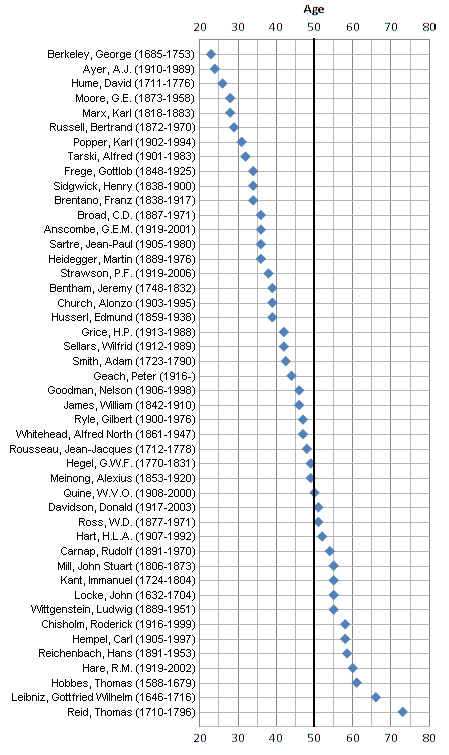If you're the kind of person who reads philosophy blogs, you've probably heard of inverted qualia thought experiments. The most famous example is red-green inversion: The red-green invert is someone who has reddish color experiences when she looks at green things (grass, leaves) and has greenish color experience when she looks at red things (blood, ripe tomatoes). Since the invert, like the rest of us, learns the meaning of color terms by example, her language and behavior is entirely, or at least virtually, indistinguishable from anyone else's. She uses the English word "red" to refer to the color of blood and "green" to refer to the color of grass, despite the difference in her color experiences of those things.
In a talk at UC Riverside a couple of weeks ago, Saul Kripke asserted that no philosopher had ever suggested the possibility of sound-color qualia inversion -- that is, the possibility of a person who experiences sound qualia when stimulated by light and color qualia when stimulated by sonic vibrations. Let's be clear that Kripke was not denying the possibility of synaesthesia. He was not denying that people sometimes (for example) experience colors alongside sounds when stimulated by sounds. Kripke's claim, rather, was that no philosopher had contemplated a true sound-color qualia invert -- someone who normally experiences sound rather than color when stimulated by light and color rather than sound when stimulated by sonic vibration and whose language and behavior from the outside is indistinguishable from that of non-inverts.
Kripke said this twice. I told him I was pretty sure he was wrong and that I had read such a discussion. Kripke challenged me to send him the citation. After a little research, I turned up my source: an unpublished essay by one of my graduate students, Nathan Westbrook. When I asked Nathan whether he knew of any precedents, he said he didn't. I also tried asking someone who had recently published a review of the qualia inversion literature; he too said he didn't know of anyone who had advanced that type of example.
But given the huge number of philosophy articles published each year and the prominence of qualia inversion examples, I feel sure someone must have discussed this kind of case somewhere. Therefore, I offer a challenge: Find a published discussion of sound-color qualia inversion. The winner will receive a "valuable prize" -- hm, what can I offer? How about: a drink of your choice (coffee, beer, whatever) on me, next time we are in the same city. (Okay, maybe that's no so valuable.)
Rules:
* The contest is open until June 14th or until someone delivers a satisfactory example, whichever comes later.For the record, I lean toward thinking that sound-color qualia inversion is possible in a conceptual/metaphysical/pulling-it-out-of-my-a-priori-hindquarters-for-the-little-that's-worth sense of possibility.
* To be satisfactory, the discussion must be published in a reputable philosophy journal or press.
* To be satisfactory, the discussion need not ultimately endorse the possibility of color-sound qualia inversion, just take it seriously.
* If more than one satisfactory example is submitted, the person who submits the best example will be declared the winner, where I will judge "best" impressionistically, criteria including but not limited to: the length and quality of the discussion, the prominence of the writer or venue, and how seriously the possibility is taken.
* If more than one person submits the best example, the first person to submit the best example will be declared the winner.
* Submit your example as a comment on this post or by email to me.
Color experiences famously differ along three dimensions: hue, saturation, and lightness or brightness. They also differ in egocentric, subjective location. To work an inversion with sound, we need a one-to-one mapping of dimensions of variation. Subjective location would appear to be easy, since both colors and sounds have subjective location. Since brightness and saturation are both unidimensional, we might be able to map them one-to-one onto pitch and volume, which are also unidimensional. Hue varies in a bit more complex a way, with red-green as opposites and blue-yellow as opposites, but perhaps patterns in the overtone series could be used. Probably the hue-overtone series mapping would require some tweaking to work, but presumably human-like beings with a slightly different set of visual and auditory capacities could exhibit a clean mapping (e.g., if the beings were only capable of discriminating certain patterns in overtone variation). Another complication is our much higher sensitivity to variation in visual as opposed to auditory position. But I don't see why, for the purposes of the thought experiment, we shouldn't be liberal about such matters: The sound-color invert, for example, might be an invert only of a relatively poor-sighted person and/or might have an exquisite appreciation of subtle variations in the












